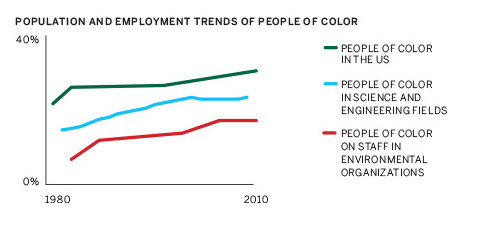
The report, “The State of Diversity in Environmental Organizations: Mainstream NGOs, Foundations & Government Agencies,” is the most comprehensive report on diversity in the environmental movement. It surveyed 191 environmental non-profits, 74 government environmental agencies, and 28 leading environmental grant making foundations to investigate their gender and racial diversity composition, the majority of which state diversification as a “value.” The study included confidential interviews of 21 environmental leaders from diverse backgrounds and experience.
Report Findings:
1. The Green Ceiling
Despite increasing racial diversity in the United States, the racial composition in environmental organizations and agencies has not broken the 12% to 16% “green ceiling” that has been in place for decades.
2. Unconscious Bias, Discrimination, and Insular Recruiting
Confidential interviews with environmental professionals and survey data highlight alienation and “unconscious bias” as factors hampering recruitment and retention of talented people of color.
3. Lackluster Effort and Disinterest in Addressing Diversity
Efforts to attract and retain talented people of color have been lackluster across the environmental movement.
The Result: An overwhelmingly white “Green Insiders’ Club.”

The Green Ceiling
• People of color are 36% of the U.S. population, and comprise 29% of the science and engineering workforce but they do not exceed 16% of the staff in any of the organizations surveyed. • For decades, environmental organizations have stressed the value of diversity however the diversity compostion has not broken the 16% green ceilling. • People of color support environmental protection at a higher rate than whites. However, environmental organizations are not adequetely reaching out to organizations representing people of color communities.


Unconscious Bias, Discrimination, and Insular Recruiting
The failure of environmental organizations and agencies to increase recruitment and retention of people of color comes despite the disproportionate impact of environmental hazards on communities of color and the fact that people of color poll higher than whites in support for environmental issues. Environmental organizations fail to use the existing internship pipeline effectively. As a result, diversity decreases as responsibility increases. None of the largest budget organizations had a president, vice president, or assistant/associate director who was a person of color.

Lackluster Effort and Disinterest in Addressing Diversity
Despite making some gains, significant and intentional work remains to make the mainstream environmental movement welcoming to people of color, according to confidential interviews with 21 environmental leaders. Unfortunately, mainstream NGO, foundation and government agency survey respondents show an unwillingness to participate in needed initiatives to change the status quo.

A RAY OF HOPE
Across the three types of organizations studied, the number one diversity initiative is promoting women. When environmental organizations commit the necessary resources, they show significant progress in increasing staff and leadership diversity. Women now represent:
- More than half of 1,700+ leadership positions studied. Most of these are White women.
- 70% of executive directors’ positions in environmental grant making foundations.
- But, only 30% of top positions, including presidents and board chairs.
Recommendations for Diverse Leadership and Inclusive Workplaces
The decade ahead will mirror the last without aggressive efforts in three critical areas: In order to accelaterate the representaton of people of color in environmental organizations the board and executive leadership require priority attention.
Tracking and Transparency
- Diversity statements without a plan and rigorous data collection are just words on paper. Organizations and associations should institute annual diversity and inclusion assessments.
- Disclosure should facilitate sharing of strategies for addressing unconscious bias and overhauling recruiting beyond the green insiders’ club.
Accountability
- Foundations, NGOs, and government agencies should integrate diversity goals into performance evaluations and grant making criteria.
- The environmental field’s associations should use their convening role to showcase leaders and laggards on increased diversity.
Resources
- Increased resources must be allocated for diversity initiatives to work.
- Provide sustainable funding for networking to reduce isolation and support existing leaders of color.
Who is making an impact?
Foundations
With regular diversity reports and consistent data reporting, the Rockefeller Brothers Fund, the California Endowment, Jessie Smith Noyes Foundation, and the Foundation Center’s “Glass Pockets” initiative are leading the way on how organizations can track and disclose this data.
- The Rockefeller Brothers Fund releases biannual reports to detail success on stated goals, including engaging diverse constituents and recruiting a diverse board.
- California Endowment added racial and ethnic data to its grant application process and regularly publishes data on their grant making to organizations of color.
- Jessie Smith Noyes Foundation partners with and supports D5, a five-year coalition to grow philanthropy’s diversity, equity, and inclusion.
Government’s Strategic Plan for Diversity and Inclusion
In 2011, the Obama Administration introduced Executive Order (EO) 13583. It established a coordinated governmentwide initiative to promote diversity and Inclusion in the Federal Workforce. This may contribute to the higher interest for comprehensive diversity strategies seen by government agencies. The three pillars are:
- Workforce Diversity. Recruit from a diverse, qualified group of potential applicants to secure a high-performing workforce drawn from all segments of American society.
- Workplace Inclusion. Cultivate a culture that encourages collaboration, flexibility, and fairness to enable individuals to contribute to their full potential and further retention.
- Sustainability. Develop structures and strategies to equip leaders with the ability to manage diversity, be accountable, measure results, refine approaches on the basis of such data, and institutionalize a culture of inclusion.
Leaders Identify Factors that Make Diversity Initiatives Successful
- Adequate and stable funding.
- Adequate and committed leadership.
- Adequate organizational buy-in.
- Ability to communicate across race, class, gender, and cultural lines.
- Institutionalizing diversity, equity, inclusion goals.
- Translate diversity training into action.
About the Author
Dorceta E. Taylor is a professor at the University of Michigan’s School of Natural Resources and Environment. Professor Taylor was the first Black woman to earn a Ph.D. from the Yale School of Forestry and Environmental Studies. She is the author of the award-winning book, The Environment and the People in American Cities, 1600s-1900s: Disorder, Inequality, and Social Change (Duke University Press, 2009). Her most recent book is Toxic Communities: Environmental Racism, Industrial Pollution, and Residential Mobility (New York University Press, 2014). Professor Taylor is the founder of the Minority Environmental Leadership and Diversity Initiative.
Support for this report was provided by:
National Fish and Wildlife Foundation, Arcus Foundation, Sierra Club, and Earthjustice
Green 2.0 Working Group
(Organizations listed for affiliation purposes only.) Alaina Beverly (University of Chicago); Angela Park (Mission Critical); Don Chen (Ford Foundation); Donna Hope (Institute for Market Transformation); Felicia Davis (Building Green Initiative at Clark Atlanta University); Jalonne L. White-Newsome (WE ACT for Environmental Justice); Jenni LeBlanc (National Audubon Society); Kim Noble (Green for All); Leslie Fields (Sierra Club); Lisa Garcia (Earthjustice); Marcelo Bonta (Center for Diversity and the Environment); Mark Magaña (GreenLatinos); Michael Dorsey (Joint Center for Political And Economic Studies/Sierra Club); Mustafa Ali (U.S. Environmental Protection Agency); Patrice Simms (Howard University School of Law); Patrice Webb (The Webb and Flow Group); Quentin James (Vestige Strategies); Roger Rivera (National Hispanic Environmental Council); Shamar Bibbins (Independent Consultant); Stephanie Maddin (Earthjustice); Tracy Russ (Russ Communications); Vernice Miller-Travis (Maryland State Commission on Environmental Justice and Sustainable Communities); Robert Raben, Danielle Deane, Karen Marangi, Larry Gonzalez, Beth Lynk, Alex Przybelski, Robert Avruch, Jonathan Kent (The Raben Group)

